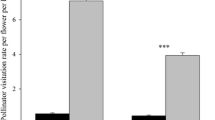Abstract
Human activity often causes a decline in the local density of plant populations. Below some critical lower density, populations may suffer a progressive decline in reproductive success because of the difficulties associated with finding suitable mates. Therefore, to conserve endangered plant species it is necessary to understand in greater detail how changes in population density affect different determinants of plant reproductive success. We simultaneously recorded individual plant pollination success, reproductive effort and fruit parasitism in three populations of Cistus ladanifer L. in eastern Portugal. Pollination success declined significantly as distance to the nearest conspecific increased (p<0.001). However, reproductive effort and fruit parasitism showed the opposite pattern (both p<0.001). On average, plants farther than 1 m from their nearest conspecific suffered from three times more fruit parasitism compared to plants closer to a conspecific. Overall, net female reproductive output decreased as nearest neighbor distance rose (p<0.001). Thus, isolated plants were able to compensate only partially for reduced pollination success through increased reproductive effort. We conclude that management plans for plant populations should recognize that reproductive success is the accumulated result of several different processes, which may each respond to plant density in different ways.
Similar content being viewed by others
References
Allee W.C. (1951) The Social Life of Animals, 2nd edition. Beacon Press, Boston
Allee W.C., Emerson A.E., Park O., Park T., Schmidt K.P. (1949) Principles of Animal Ecology. W.B. Saunders Company, Philadelphia
Atsatt P.R., O’Dowd D.J. (1976) Plant defense guilds. Science 193:24–29
Bastida F., Talavera S. (2002) Temporal and spatial patterns of seed dispersal in two Cistus species (Cistaceae). Ann. Bot. 89:427–434
Burd M. 1994. Bateman's principle and plant reproduction: the role of pollen limitations in fruits and seed set. Bot. Rev. 60:83–139
KlinKhamer PlG.L. and de Jong T.J. (1990) Effects of plant size, plant density and sex differential nectar reward on pollinator visitation in the protandrous Echium vulgare (Boraginaccae). Oikos 57:399–405
Kunin W.E. (1993) Sex and the single mustard: population density and pollinator behavior effects on seed-set. Ecology 74:2145–2160
Kunin W.E. (1999) Patterns of herbivore incidence on experimental arrays and field populations of ragwort, Senecio jacobaea. Oikos 84:515–525
Larson B.M.H., Barrett S.C.H. (2000) A comparative analysis of pollen limitation in flowering plants. Biol. J. Linn. Soc. 69:503–520
Mustajarvi K., Siikamaki P., Rytkonen S., Lammi A. (2001) Consequences of plant population size and density for plant-pollinator interactions and plant performance. J. Ecol. 89:80–87
Otway S.J., Hector A., Lawton J.H. (2005) Resource dilution effects on specialist insect herbivores in a grassland biodiversity experiment. J. Anim. Ecol. 74:234–240
Pielou E.C. (1977) Mathematical Ecology. Wiley, New York
Rathcke B. (1983) Competition and facilitation among plants for pollination. In: Real L. (eds) Pollination Biology. Academic Press, Orlando, pp 305–329
Root R.B. (1973) Organisation of a plant–arthropod association in simple and diverse habitats: the fauna of collards (Brassica oleracea). Ecol. Monogr. 43:95–124
Serrano J.M., Delgado J.A., Lopez F., Acosta F.J., Fungairino. S.G. (2001) Multiple infestation by seed predators: the effect of loculate fruits on intraspecific insect larval competition. Acta Oecologia 22:153- 160
Stanton M.L., Bereczky J.K., Hasbrouck H.D. (1987) Pollination thoroughness and maternal yield regulation in wild radish, Raphanus raphanistrum (Brassicaceae). Oecologia 74:68–76
Talavera S., Gibbs P.E., Herrera J. (1993) Reproductive biology of Cistus ladanifer (Cistaceae). Plant Syst. Evol. 186:123–134
Wilcock C., Neiland R. (2002) Pollination failure in plants: why it happens and when it matters. Trends Plant Sci. 7:270–277
Acknowledgements
This project was, to a large extent, supported financially by an M.Sc project grant from the School of Biology, University of Leeds. Thanks go to the following people whose input significantly improved the manuscript; Chris Thomas and Steve Sait. We are deeply indebted to Manuela Pires da Fonseca and Joao Tiago Sabino Marques for providing extensive logistical support and advice in the field.
Author information
Authors and Affiliations
Corresponding author
Rights and permissions
About this article
Cite this article
Metcalfe, D.B., Kunin, W.E. The effects of plant density upon pollination success, reproductive effort and fruit parasitism in Cistus ladanifer L. (Cistaceae). Plant Ecol 185, 41–47 (2006). https://doi.org/10.1007/s11258-005-9082-3
Received:
Accepted:
Published:
Issue Date:
DOI: https://doi.org/10.1007/s11258-005-9082-3




